1. 单瓣型Single.
It has one row of not over eight petals, which can be regular, irregular or loosely arranged about a central, conspicuous stamen cluster, but without petaloids. 'Spencers Pink', 'Kamohonnami', and 'Alba Simplex' are typical examples. The Japanese, who favor the single type, have again divided this group into six classes:
单瓣型是一排不超过8瓣的花型,花瓣围绕一个中心规则的,不规则或松散的排列;有显眼的雄蕊,但是雄蕊周围没有花蕊瓣,山茶品种Camellia japonica 'Alba Simplex'是典型代表。喜欢单瓣型的日本人再次将这一群体分为六类:
| ID |
Standardized Name 标准名(英、中,日) |
Description 描述 |
Sample Photo 示例图 |
| 11 |
Standard 单瓣标准型 筒咲き |
This is the typical wild Camellia japonica flower form with five to seven irregular, overlapping petals in a single row and a more or less columnar stamen cluster. 单瓣标准型是典型的野生山茶花花型,有5-7个不规则且重叠的单行围绕的花瓣,和一个或多或少的柱状雄蕊簇。 |
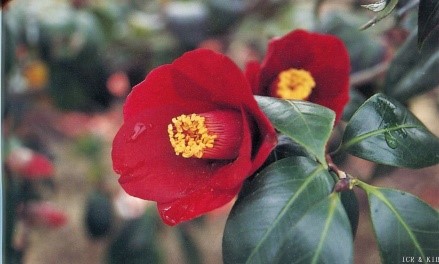 |
| 12 |
Campanulate 单瓣喇叭型 ラッパ咲き |
This is the trumpet shaped single of petals with narrow bases and reflexed apices and a columnar or tubular stamen cluster. 该花型是有狭窄的基部和放射状的顶端,形似喇叭的单瓣花型;有一个管柱状的雄蕊簇。 |
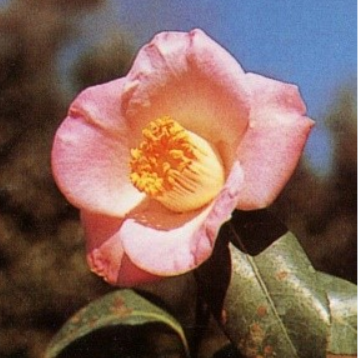 |
| 13 |
Wabisuke 佗助型 猪口咲き(ワビスケ咲き) |
This is a miniature to small single form, usually vase shaped with an abortive stamen centre. 陀助型是一种微缩的单瓣花型,通常花瓶形状,有一个不育的雄蕊簇。 |
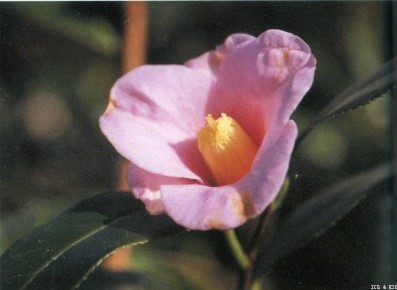 |
| 14 |
Cup-shape 杯型 盃状咲き(盃咲き) 椀咲き |
Known as sake cup shaped in Japan. In this form the base of the petals are broader and the bloom, when open, is truly cup shaped with none or little reflecting of the apex. Stamen cluster can vary from columnar to spreading. 该单瓣花型在日本称为“清酒杯”。杯型山茶的花瓣基部更宽,在花瓣盛开时才呈现出杯形,并且极少在花瓣顶端反射。雄蕊簇从柱状到展开不等。 |
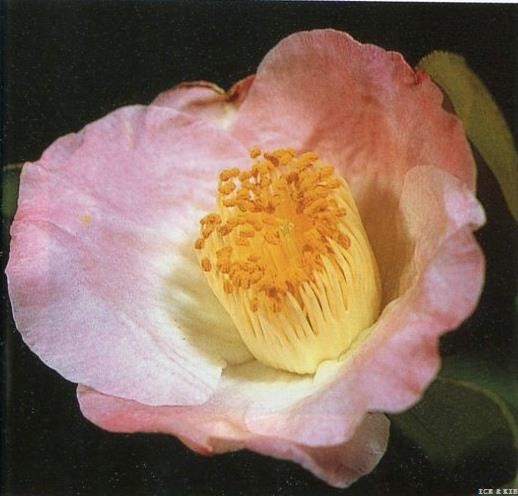 |
| 15 |
Spherical 包圆型 抱え咲き |
This is called the 'male-in-one' form in Japan and refers to single flowers where the petals are incurved to obscure the stamens. 包圆型在日本被称为“雄合一”,泛指花瓣弯曲以遮挡雄蕊的单花。 |
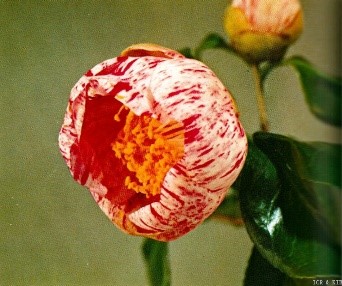 |
| 16 |
Saucer-shape 肥后型或碟型 平開咲き |
In this case the single blooms open almost flat with a strong stamen centre. The typical Higo camellia, if not more than eight petals, falls within this type. The stamens can be circular or spreading. 在肥后型和蝶型中,单花几乎平坦开放,中心的雄蕊也盛放绽开。典型的 Higo camellia(肥后山茶)如果花瓣不超过8瓣全部属于该花型。雄蕊可以是圆形或者展开。 |
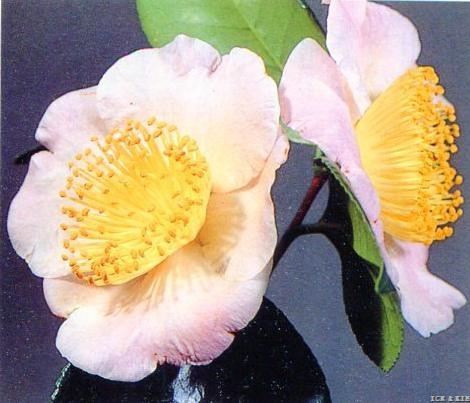 |
2. 半重瓣型semi-double.
It has in excess of eight petals in two or more rows, with a conspicuous stamen centre, with no petaloids. The petals may be regular, irregular or loose. Examples are 'The Czar', 'Akashigata', 'Finlandia' '. In Japan this class is divided into three types:
半重瓣型有每行超过8瓣的两排或多排花瓣,中心的雄蕊明显,没有花蕊瓣。花瓣可以是规则的,不规则的或松散的排列在雄蕊周围。例如“The Czar”(陛下)、“Akashigata”(明石潟)、“Finlandia”(芬兰)这三个品种。在日本,这一类又被分为三种类型:
| ID |
Standardized Name 标准名(英、中,日) |
Description 描述 |
Sample Photo 示例图 |
| 21 |
Standard 荷花型 蓮華咲き |
It has two or three rows of imbricated petals. In China this form is known as the lotus. 荷花型有两排或三排像瓦片一样重叠的花瓣。在中国这种花型被称为“莲花”。 |
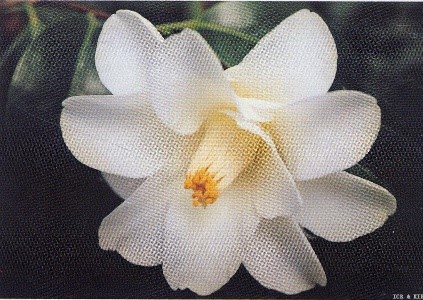 |
| 22 |
Magnolia 玉兰型 八重咲き |
In China the magnolia form is a single of the shape of a Mignolia denudata bloom. 在中国,玉兰型的形态是一朵玉兰绽放的单花形状。 |
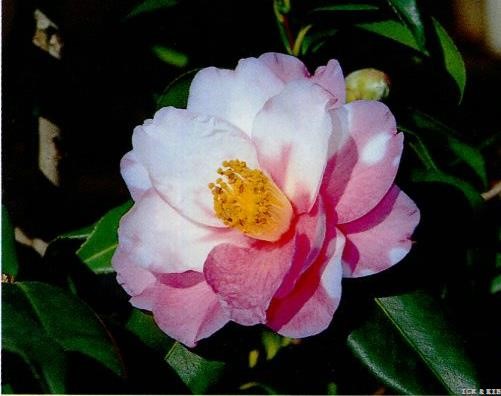 |
| 23 |
Doubleness(hose-in-hose) 双层瓣型 二段咲き |
This has the appearance of a second flower superimposed on the first and, in Japan, is fairly common with the larger 'Snow camellia' (C. rusticana) cultivars, although rarely seen in the West. 形态像是一朵叠加在另一朵上的称为双层瓣型。虽然这种花型在西方比较罕见,但双层瓣型中比较大的原种雪椿(C. rusticana)在日本相当常见。
|
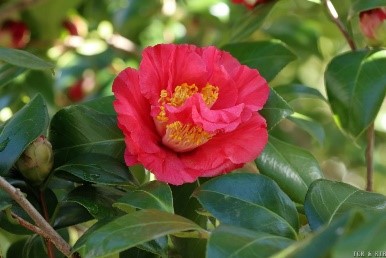 |
3. 托桂型Anemone form.
This form is the same in the Orient or the West, and has one or more outer rows of large petals while, in the centre, the stamens have become almost totally petaloid and form a convex mass in the centre of the flower.
托桂型的形态在东西方是一致的,它同时有一排或更多排大花瓣;中心的雄蕊几乎全部变为花蕊瓣,并花的中心形成一个凸状团。
| ID |
Standardized Name 标准名(英、中,日) |
Description 描述 |
Sample Photo 示例图 |
| 31 |
Single 托桂型 唐子咲き |
It has one row of outer petals and a very compact centre. 'Anemoniflora' and 'Bokuhan' are typical examples. 托桂型有一排外花瓣和一个非常紧凑的中心。“Anemoniflora”(宝珠)和“Bokuhan”(卜伴)这两个品种就是典型的例子。 |
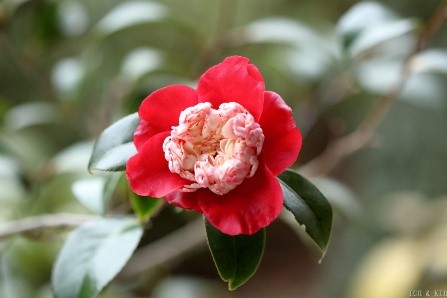 |
| 32 |
Multiple rows of outer petals 外瓣多层 |
It is larger with two or three rows of outer petals and a more open central mass, sometimes with many small petals as well as petaloids. 'Elegans', 'C. M. Wilson' and 'Extravaganza' are examples. 多瓣多层是更大的托桂花型,它有两排或三排外花瓣和更开放的中心团,有时中心有很多小花瓣以及花蕊瓣。例如品种“Elegans”(雅致)、“C. M. Wilson”(牧童之神)、“Extravaganza”(粉奇作) |
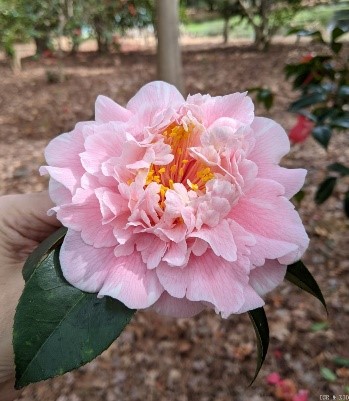 |
4.牡丹型Peony form.
It also known as the informal double.
牡丹型也叫做“不完全重瓣型”。
| ID |
Standardized Name 标准名(英、中,日) |
Description 描述 |
Sample Photo 示例图 |
| 41 |
Peony 松散牡丹型 牡丹咲き |
The loose informal double, or the incomplete informal double. This has loose petals, usually irregular or wavy, becoming smaller-to the centre, where they are divided by fascicles of stamens; sometimes the centre is a mixture of small petals, petaloids and stamens. Examples are 'Betty Sheffield', 'Kick-off' and 'Emperor of Russia'. 松散牡丹型或不完全重瓣型。该型的花瓣松散,通常呈不规则形或者波浪形,到中心时变小并被雄蕊的束分开;有时花的中心是小花瓣、花蕊瓣和雄蕊的混合物。例如品种“Betty Sheffield”(贝蒂)、“Kick-off”(开赛)、“Emperor of Russia”(苏联皇帝)。 |
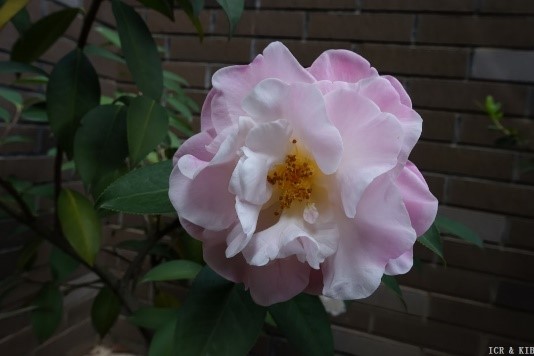 |
| 42 |
Full(no stamen) 牡丹型 獅子咲き |
The full or complete peony, or the complete informal double. This is usually a convex mass of a mixture of irregular, twisted petals and petaloids, with the stamens, if any, obscured. Examples are 'Debutante' and 'Madame Picouline'. 牡丹型是完全或完整的牡丹,或是完全重瓣型。该型通常是一个混合了不规则的扭曲花瓣和花蕊瓣的凹形团,如果有雄蕊会被花瓣遮挡。例如“Debutante”(迪牡丹)、“Madame Picouline”。 |
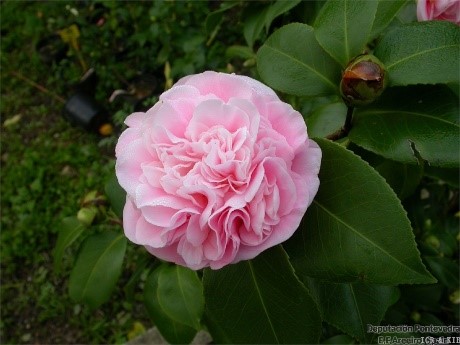 |
5.玫瑰型(蔷薇型)Rose form.
| ID |
Standardized Name 标准名(英、中,日) |
Description 描述 |
Sample Photo 示例图 |
| 51 |
Standard 标准玫瑰型 バラ咲き |
This has multiple rows of imbricated petals, opening through a bud-shaped centre to show some stamens in a concave centre when fully open. Examples are 'Shiragiku', 'Red Robin' and 'Sharon Rose'. 标准玫瑰型有多排像瓦片一样重叠的花瓣,当完全开放的时候通过一个芽形中心的绽放在凹形中心显示一些雄蕊。例如品种“Shiragiku”(贞洁)、“Red Robin”、“Sharon Rose”。 |
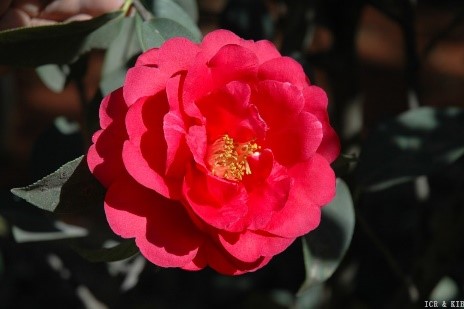 |
| 52 |
Bud-centered 牙尖中心玫瑰型 宝珠咲き
|
The centre petals remain firmly embraced, forming a bud like centre. Because this bud centre is similar to the pointed ball pediments known as 'honju', seen in Japan and China on posts and towers, it is named the 'honju' form in Japan. 牙尖中心玫瑰型开花时中心花瓣仍然牢牢拥抱着,中心像一个芽的的形状。 |
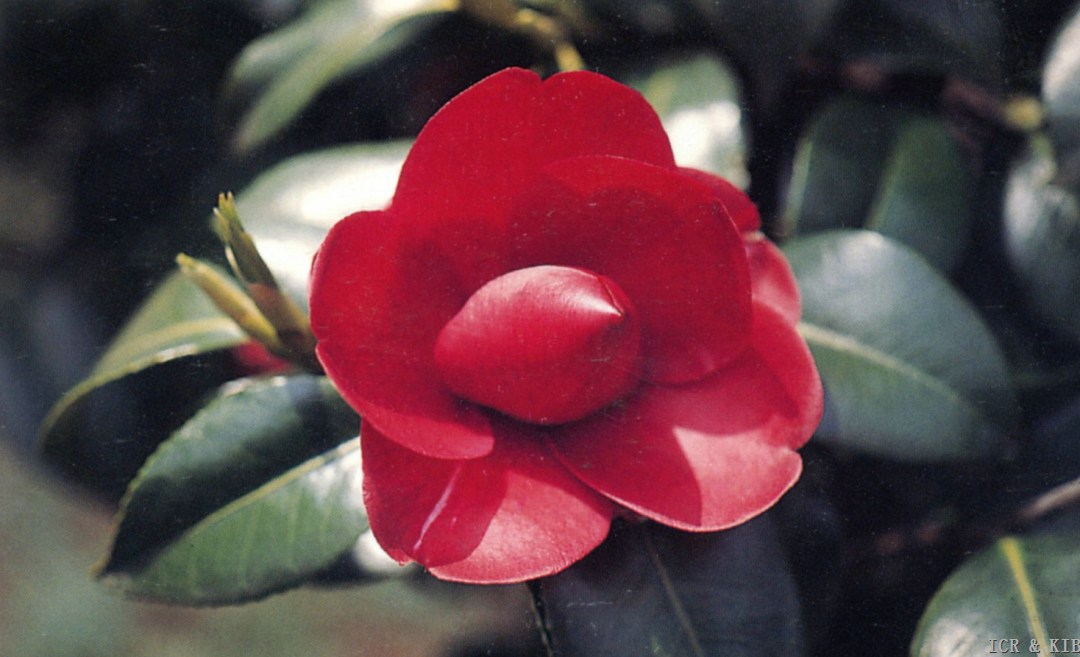 |
6. 完全重瓣型Formal double.
It has many rows of regular, overlapping petals and has no stamens. It was called the 'perfection' in the 19th century.
完全重瓣型有许多规则,重叠的花瓣,无雄蕊。在十九世纪称为“完美”。
| ID |
Standardized Name 标准名(英、中,日) |
Description 描述 |
Sample Photo 示例图 |
| 61 |
Imbricate 全重瓣型 千重咲き |
There is the usual, fully imbricated formal double, such as 'Alba Plena' and 'C.M. Hovey'. 完全重瓣型有正常的,完全的重瓣,例如品种“Alba Plena”(白宝塔)、“C. M. Hovey'”(霍维)。 |
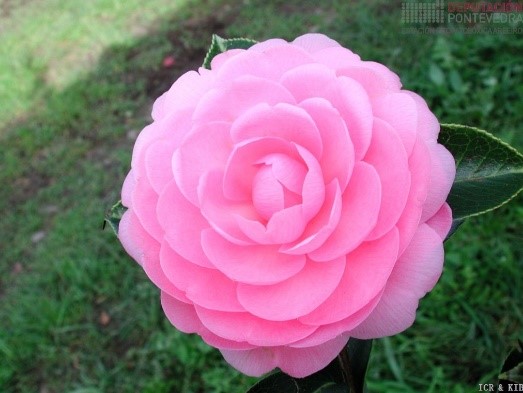 |
| 62 |
Tiered 六角型 列弁咲き |
There is the tiered form where the petals are arranged to form a star shape. This is called the procession form in Japan or hexangular or radiate type in China. 'Incarnata' and 'Hexangularis' often open with this form. 六角型有分层,花瓣呈星形排列。这是日本比较正统的叫法,在中国则叫做“六角”或“辐射型”。品种“Incarnata”(东方亮)和“Hexangularis”通常以该花型开放。 |
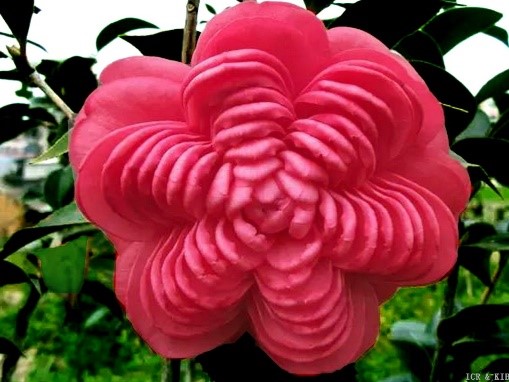 |
| 63 |
Spiral 螺旋型 |
A rarer form is the spiral form where the petals are arranged in rows in such a manner to form a five armed or seven armed spiral. The most famous Camellia with this form is the Italian ' Vergine di Collebeato '. 螺旋型时一种罕见的花型。该花型是以一种五个到七个螺旋的方式排列。最著名的品种是意大利的“Vergine di Collebeato”(圣母)。 |
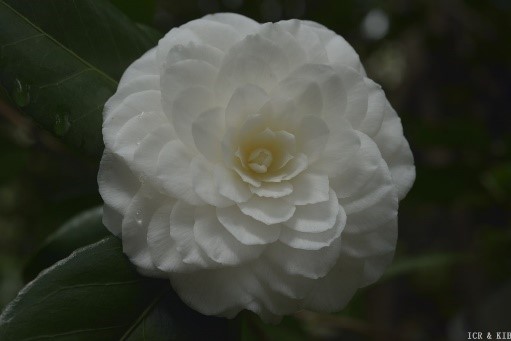 |